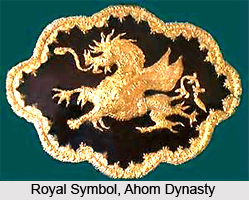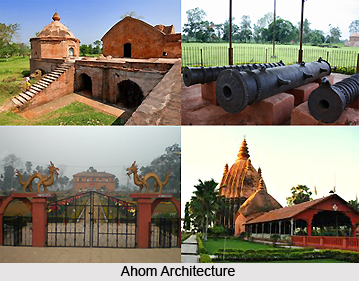 Sudingphaa was also famous as Chandrakanta Singha who was a Tungkhungia ruler of the Ahom Dynasty of the extensive Ahom kingdom who reigned from 1811 till 1818 and again from 1819 till 1821 as he was crowned twice as the king. His rule was marked with the conquest of Burmese on Assam and thereafter its occupation by the British East India Company. His first phase of regime concluded when he was dethroned by Ruchinath Burhagohain who placed Purandar Singha on the royal throne and his second reign came to an abrupt end when he was defeated by the invading Burmese troops.
Sudingphaa was also famous as Chandrakanta Singha who was a Tungkhungia ruler of the Ahom Dynasty of the extensive Ahom kingdom who reigned from 1811 till 1818 and again from 1819 till 1821 as he was crowned twice as the king. His rule was marked with the conquest of Burmese on Assam and thereafter its occupation by the British East India Company. His first phase of regime concluded when he was dethroned by Ruchinath Burhagohain who placed Purandar Singha on the royal throne and his second reign came to an abrupt end when he was defeated by the invading Burmese troops.
Sudingphaa kept his military conquests alive, with a hope to reconquer his own territories from Purandar Singha and surrendered to the Burmese who convinced him that they would crown him the ruler of Ahom as he revolted against Purandar Singha and joined the Burmese soldiers. However, Sudingphaa was attacked and imprisoned at Rangpur. Following the First Anglo-Burmese War and the Treaty of Yandabo, 1826 CE, Assam slipped into the control of the British and several members of the royal family of Assam were offered pensions. The British granted Sudingphaa a pension amounting to 500 rupees and he initially resided in Kaliabor. Later, he shifted to Guwahati. He made a final attempt at restoring his lost kingdom when he visited Kolkata and died during 1839 CE upon returning to Kolkata.
Ancestry of Sudingphaa
Chandrakanta Singha or Sudingphaa was the second son of Numali Rajmao and Kadamdighala Gohain, the grandson of Rudra Singha`s younger brother named Namrupia Raja. During 1795 AD, Kadamdighala Gohain was the Charingia Raja after the death of Gaurinath Singha at Jorhat. As he had cooperated with Purnananda Burhagohain in containing the Moamoria revolt, the latter enabled Kinaram Gohain, the elder son of Kadamdighala Gohain to emerge as the next ruler of the Ahom kingdom. At that time, Suklingphaa or Kamaleswar Singha was a mere two-year-old.
Early Life of Sudingphaa
Kamaleswar Singha or Suklingphaa was declared the new ruler of the sovereign of Ahom kingdom during 1795 CE and Chandrakanta was born during 1797 AD, immediately two years after his brother`s accession to the royal throne of Assam. Sudingphaa was brought up inside the royal palaceof Ahom in Jorhat. He developed friendship with some junior officers and palace servants during his early childhood. Amongst his close acquaintances, Satram who was the son of a royal poultry (and according to others the son of a soothsayer in Assam) and he is believed to have a considerable impact on Sudingphaa. After the demise of Kadadighala Gohain during 1799 AD, Chandrakanta Gohain or Sudingphaa was granted the titular rank of `Charing Raja`, which he continued to enjoy till he became the king.
Accession of Sudingphaa
When Kamaleswar Singha or Suklingphaa died during January 1811 on account of small-pox, Chandrakanta Gohain was appointed as the next ruler of Ahom Dynasty by the Prime Minister Purnananda Gohain. At that point of time, Chandrakanta`s age was only 14. It is said that the young Chandrakanta was extremely nervous during his coronation ceremony due to the presence of innumerable guests in the audience and refused to be seated on the throne unless his close friend Satram stood beside him, close to the throne. Reluctantly, the nobles agreed and Chandrakanta was proclaimed the king of Ahom kingdom and given the title of Swargadeo Chandrakanta Singha. The name `Sudingphaa` was conferred on him by the Tai-Ahom priests at the coronation event. However, the coronation ceremony was quite exorbitantly priced, being known as `Singarigharutha`, on account of the acute financial crisis which was prevailing in that part of the country.
First Reign of Sudingphaa
As Chandrakanta Singha was quite young during the time of his accession to the throne, the majority of the administrative powers and control was exercised by his Prime Minister Purnananda Burhagohain who conducted add forms of commerce and trade in the name of the king. He accompanied Sudingphaa to several significant offices to instil confidence in the minds of their subjects, about the Ahom monarchy. The young prince Chandrakanta indulged in all forms of pleasures of the royal palace, playing with palace maids and his own friends in Jorhat while Purnananda managed crucial matters of the Ahom kingdom.
 Chandrakanta started feeling uneasy under the strong influence of Purnananda Burhagohain and ultimately was capable of wriggling free from the control of the latter with the aide of Satram who was granted the rank of `Charingia Phukan`. Sudingphaa trusted Satram and paid great attention to Satram`s opinions about the court nobles, seated by his side at the throne, much to the irritation of the nobles. Despite Purnananda`s opposition, he married Padmavati, the daughter of a commoner or disciple of `Bengena-atia Satra`. He raised her to the rank of the `Chief Queen` or `Parvatia Konwari`, thereby violating the ancient royal tradition which asserted that wives should be selected from important Ahom families. Reacting vehemently against Sudingphaa`s marriage to Padmavati, the nobles of Purnananda refused to offer the customary royal salute to the Chief Queen which fuelled hostility between the king and his Prime Minister.
Chandrakanta started feeling uneasy under the strong influence of Purnananda Burhagohain and ultimately was capable of wriggling free from the control of the latter with the aide of Satram who was granted the rank of `Charingia Phukan`. Sudingphaa trusted Satram and paid great attention to Satram`s opinions about the court nobles, seated by his side at the throne, much to the irritation of the nobles. Despite Purnananda`s opposition, he married Padmavati, the daughter of a commoner or disciple of `Bengena-atia Satra`. He raised her to the rank of the `Chief Queen` or `Parvatia Konwari`, thereby violating the ancient royal tradition which asserted that wives should be selected from important Ahom families. Reacting vehemently against Sudingphaa`s marriage to Padmavati, the nobles of Purnananda refused to offer the customary royal salute to the Chief Queen which fuelled hostility between the king and his Prime Minister.
Satram`s Conspiracy against Purnananda
Though Satram and Sudingphaa were of the same age, the former was unsurpassed in his shrewdness and evil designs. He started to accumulate support against Purnananda Burhagohain from numerable Ahom nobles as he knew a rift between Purnananda and Sudingphaa would help him realize his ambitions as he held the main power. He misread the goals of Purnananda and complained against him to Chandrakanta and Badan Chandra Borphukan, the viceroy of Guwahati. Badan Chandra was persuaded that Purnananda was secretly planning to assassinate him. His plan of murdering Purnananda backfired and was discovered. He was proved guilty at the Grand Council of the three Burhagohains comprising Borgohain, Borpatrogohain and Purnanada Burhogohain, and banished to Namrup. Satram was killed here in 1814.
Second Reign of Sudingphaa
Sudingphaa was established on the throne by the Burmese troops in 1819 after the retreat of Purandar Singha and Ruchinath Burhagohain to Jorhat. After the second Burmese invasion, the Burmese went back to Amarapura and meanwhile Momai Baruah stayed back in Assam with Mingimaha Tilowa Baju Paya and Sajati Phukan, his two commanders. Ruchinath Burhagohain and Purandar Singha reorganised their forces in the region of Guwahati. Then Momai Baruah proceeded towards Guwahati and was counter-attacked by the troops of Bhisma Gogoi Borphukan which was released by Purandar Singha. The Assamese soldiers were defeated in a fierce battle of Khagarijan which is represented by current-day Nagaon, on 11th June, 1819. Guwahati was occupied by the Burmese while Purandar Singha retreated to Bengal. Along with Ruchinath Burhagohain, Purandar Singha requested Lord Hastings, the British Governor General to enable them to retrieve their lost kingdom. Since the British refused to cooperate, both the sides were helpless.
Burmese Invasions of Ahom
The latter part of 1816 witnessed the arrival of nearly 8, 000 men under the supervision of General Maha Minhla Minkhaung, which represented the First Burmese Invasion of Ahom which was sent from Burma. Chiefs of Manipur, Mungkong and Hukong joined the army and Garbhe Sing Raja was to be placed on the throne as per the Burmese. An army was sent by Purnananda Burhagohain to stop the invaders, who is said to have committed suicide. Ruchinath, his elder son was made the next Burhagohain and Ahom forces faced defeat near Kathalbari and Burmese plundered and burnt many villages as they marched. Jorhat was occupied by the Burmese and Badan Chandra Borphukan assumed complete control of Ahom kingdom as the `Mantri-Phukan`. An Ahom princess, Hemo Aideo was offered to the Burmese king Bodawpaya, along with 50 elephants and a considerable sum of money for the expenses incurred by his army.
Friends of Badan Chandra visited Burma and conveyed the news of the death of Badan Chandra to King Bodawpaya who at once dispatched an army of 30, 000 men under the leadership of Alungmingi. An Assamese nobleman named Momai Baruah ordered the second Burmese invasion of Ahom. The Burmese forces were resisted on 17th February, 1819 close to Janji River bravely but suddenly, the commander was incapable of continuing the battle and retreated to Jorhat. Ruchinath Burhagohain and Purandar Singha looted the royal treasury which was worth 3.5 million rupees.
After the death of King Bodawpaya, his grandson Bagyisaw ascended the throne and when he learnt Chandrakanta was making attempts to shed off the Burmese influence he sent a fresh army under Mingimaha Tilowa Baju, pretending to send the Ahom king some gifts. During March 1821, the troops marched inside Assam and assassinated Patalang Borbarua, after which they tortured his wife Majiu Aideo. Chandrakanta suspected foul play from the end of the Burmese and was informed of true facts by Majiu Aideo who somehow fled from her captivity from Jaypur. Fresh armies were sent by Chandrakanta under Kalibar Burhagohain who lost against Burmese soldiers and was captured by them. Despite their best attempts to shield Assam from Burmese, in April 1821, Assam was occupied again by Burmese troops. Jogeswar Singha, the brother of Hemo Aideo was made the next ruler of Ahom kingdom in November 1821. Chandrakanta continued his efforts at trying to expel the Burmese from Assam and it is then that the triangular conquest between Sudingphaa, Purandar Singha and the Burmese broke out.
Death of Sudingphaa
Sudingphaa was terribly disappointed when he discovered that the British would not extend any of their assistance for the restoration of Ahom kingdom. Therefore he was compelled to return from Kolkata to Guwahati. Finally he died during 1839, in Guwahati in his personal residence.



















